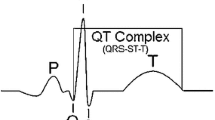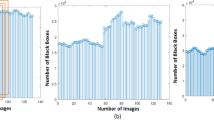Abstract
Probabilistic classification approaches have been presented for arrhythmic and ischemic data using QRS-ST evaluation. The proposed methodology is segregated into two major parts, i.e., (a) detection of QRS complex and ST segments by improvised Pan-Tompkins and difference operation method, respectively, and (b) classification of healthy, arrhythmic, and ischemic classes using linear discriminant analysis (LDA), decision tree (DT), and artificial neural network (ANN), respectively. Two correlative classification features (frequency and time domain) of QRS-ST, i.e., (1) ratio of power spectrum (PS) and power spectral density (PSD) and (2) area under the curve (AUC), are introduced to these classifiers. The algorithm is evaluated and validated with standard databases such as FANTASIA (healthy), MIT-BIH Arrhythmia (arrhythmic), and long-term ST database (ischemic), respectively. For uniform probability classification, ECG episodes with 100% sensitivity (Se) and the specificity (Sp) are included in this analytical modeling. As the experimentation is performed to validate the possibility of these features for classification, the percentage of classification certainly could be improved by considering other vital features. We conclude that correlative analysis of QRS-ST may be evoked as significant marker for arrhythmia and ischemia.
Similar content being viewed by others
References
Ghuran, A.V., Camm, A.J.: Ischaemic heart disease presenting as arrhythmias. Br. Med Bull. 59, 193–210 (2001)
Channer, K., Morris, F.: ABC of clinical electrocardiography myocardial ischemia. BMJ. 324, 1023–1026 (2002)
Pueyo, E., Sörnmo, L., Laguna, P.: QRS Slopes for detection and characterization of myocardial ischemia. IEEE Trans. Biomed. Eng. 55(2) (2008)
Pettersson, J., Pahlm, O., Cairo, E., Edenbrandt, L., Ringborn, M., Sörnmo, L., Warren, S.G., Wagner,G.S.: Changes in high-frequency QRS components are more sensitive than ST-segment deviation for detecting acute coronary artery occlusion. J. Amer. Coll. Cardiol. 36, 1827–1834 (2000)
Abboud, S., Cohen, R.J., Selwyn, A., Ganz, P., Sadeh, D., Friedman, P.L.: Detection of transient myocardial ischemia by computer analysis of standard and signal-averaged high frequency electrocardiograms in patients undergoing percutaneous transluminal coronary angioplasty. Circulation 76(3), 585–596 (1987)
Beker, A., Pinchas, A., Erel, J., Abboud, S.: Analysis of high frequency QRS potential during exercise testing in patients with coronary artery disease and in healthy subjects. Pacing Clin. Electrophysiol. 19(12), 2040–2050 (1996)
Candil, J.J., Luengo, C.M.: QT interval and acute myocardial ischemia: past promises. New Evidences Rev. Esp. Cardiol. 61(6), 561–563 (2008)
Xu, X., Liu, Y.: ECG QRS Complex Detection Using Slope Vector Waveform (SVW) algorithm. In: Proceedings of the 26th Annual International Conference of the IEEE EMBS San Francisco, CA, USA (2004)
Arzeno, N.M., Deng, Z.D., Poon, C.S.: Analysis of first-derivative based QRS detection algorithms. IEEE Trans. Biomed. Eng. 55(2) (2008)
Li, C.W., Zheng, C.X., Tai, C.F.: Detection of ECG characteristic points using wavelet transforms. IEEE Trans. Biomed. Eng. 42(1), 21–28 (1995)
Benitez, D., Gaydecki, P.A., Zaidi, A., Fitzpatrick, A.P.: The use of the Hilbert transform in ECG signal analysis. Comput. Biol. Med. 31, 399–406 (2001)
Vijaya, G., Kumar, V., Verma, H.K.: ANN-based QRS-complex analysis of ECG. J. Med. Eng. Technol. 22(4), 160–167 (1998)
Keselbrener, L., Keselbrener, M., Akselrod, S.: Nonlinear high pass filter for R-wave detection in ECG signal. Med. Eng. Phys. 19(5), 481–484 (1997)
Dokur, Z., Olmez, T., Yazgan, E., Ersoy, O.K.: Detection of ECG waveforms by neural networks. Med. Eng. Phys. 19(8), 738–741 (1997)
Kadambe, S., Murray, R., Boundreaux-Bartels, G.F.: Wavelet transform-based QRS complex detector. IEEE Trans. Biomed. Eng. 46(7), 838–848 (1999)
Afonso, V.X., Tomkins, W.J., Nguyen, T.Q., Luo, S.: ECG beat detection using filter banks. IEEE Trans. Biomed. Eng. 46(2), 192–202 (1999)
Suarez, K.V., Silva, J.C., Berthoumieu, Y., Gomis, P., Najim, M.: ECG beat detection using a geometrical matching approach. IEEE Trans. Biomed. Eng. 54(4), 641–650 (2007)
Slimane, Z.E.H., Ali, A.N.: QRS complex detection using empirical mode decomposition. Digit. Sig. Proc. (2009). doi:10.1016/j.dsp.2009.10.017
Christov, I.I.: Real time electrocardiogram QRS detection using combined adaptive threshold. BioMed. Eng. Online. 3, 28 (2004). http://www.biomedical-engineering-online.com/content/3/1/28
Romero, D., Ringborn, M., Laguna, P., Pahlm, O., Pueyo, E.: Depolarization changes during acute myocardial ischemia by evaluation of QRS slopes: standard lead and vectorial approach. IEEE Trans. Biomed. Eng. 58(1) (2011)
Karimipour, A., Homaeinezhad, M.R.: Real-time electrocardiogram P-QRS-T detection–delineation algorithm based on quality-supported analysis of characteristic templates. Comput. Biol. Med. 52, 153–165 (2014)
Portet, F., Hernandez, A.I., Carrault, G.: Evaluation of real-time QRS detection algorithms in variable contexts. Med. Biol. Eng. Comput. 43(3), 379–385 (2005)
Yeha, Y.C., Wang, W.J.: QRS complexes detection for ECG signal: the difference operation method. Comput. Meth. Programs Biomed. 91, 245–254 (2008)
Iyengar, N., Peng, C.K., Morin, R., Goldberger, A.L., Lipsitz, L.A.: Age-related alterations in the fractal scaling of cardiac inter beat interval dynamics. Am. J. Physiol. 271, 1078–1084 (1996)
Goldberger, A.L., Amaral, A.L., Glass, L., Hausdorff, J.M., Ivanov, P.C., Mark, R.G., Mietus, J.E., Moody, G.B., Peng, C.K., Stanley, H.E.: PhysioBank physiotoolkit, and physionet: components of a new research resource for complex physiologic signals. Circulation 101(23), e215–e220 (2000)
Jager, F., Taddei, A., Moody, G.B., Emdin, M., Antolic, G., Dorn, R., Smrdel, A., Marchesi, C., Mark, R.G.: Long-term ST database: a reference for the development and evaluation of automated ischaemia detectors and for the study of the dynamics of myocardial ischaemia. Med. Biolog. Eng. Comput. 41(2), 172–183 (2003)
Goovaerts, H.G., Ros, H.H., vanden Akker, T.J., Schneider, H.: A digital QRS detector based on the principle of contour limiting. IEEE Trans. Biomed. Eng BME. 23, 154 (1976)
Thakor, N.V., Webster, J.G., Tompkins, W.J.: Optimal QRS detector. Med. BioL Eng. Comput. 21, 343–350 (1983)
Sedghamiz, H.: Complete Implementation of pan tompkins [Online] (2014). Available: http://in.mathworks.com/matlabcentral/fileexchange/45840-complete-pan-tompkins-implementation-ecg-qrs-detector
Pan, J., Tompkins, W.J.: A real-time QRS detection algorithm. IEEE Trans. Biomed. Eng. BME 32(3) (1985)
Moller, M.F.: A scaled conjugate gradient algorithm for fast supervised learning. Neural Netw. 6, 525–533 (1993)
Bhoi, A.K., Sherpa, K.S., Khandelwal, B.: Classification probability analysis for arrhythmia and ischemia using frequency domain features of QRS complex. Int. J. Bioautom. 19(4), 531–542 (2015)
Author information
Authors and Affiliations
Corresponding author
Editor information
Editors and Affiliations
Rights and permissions
Copyright information
© 2018 Springer Nature Singapore Pte Ltd.
About this chapter
Cite this chapter
Bhoi, A.K., Sherpa, K.S., Khandelwal, B. (2018). Multimodal Classification of Arrhythmia and Ischemia Using QRS-ST Analysis. In: Konkani, A., Bera, R., Paul, S. (eds) Advances in Systems, Control and Automation. Lecture Notes in Electrical Engineering, vol 442. Springer, Singapore. https://doi.org/10.1007/978-981-10-4762-6_65
Download citation
DOI: https://doi.org/10.1007/978-981-10-4762-6_65
Published:
Publisher Name: Springer, Singapore
Print ISBN: 978-981-10-4761-9
Online ISBN: 978-981-10-4762-6
eBook Packages: EngineeringEngineering (R0)




